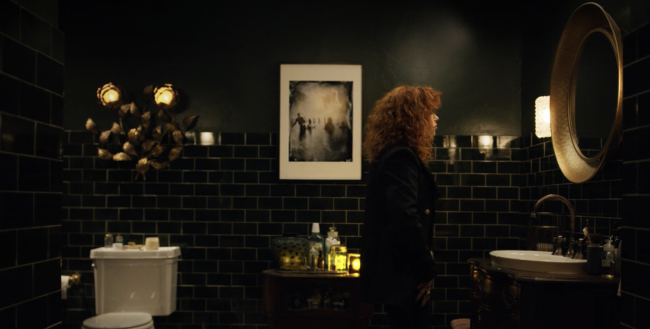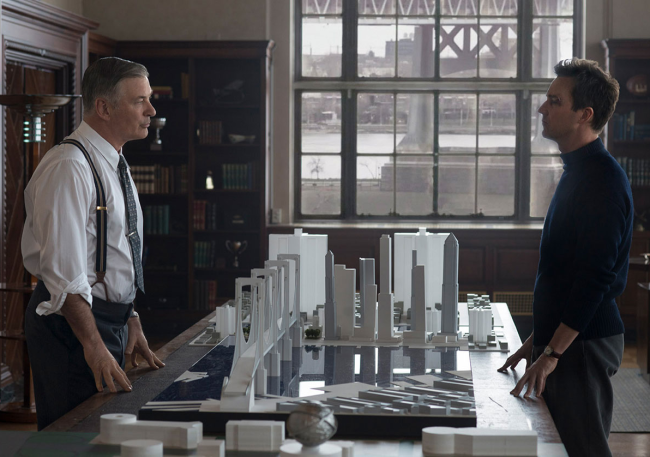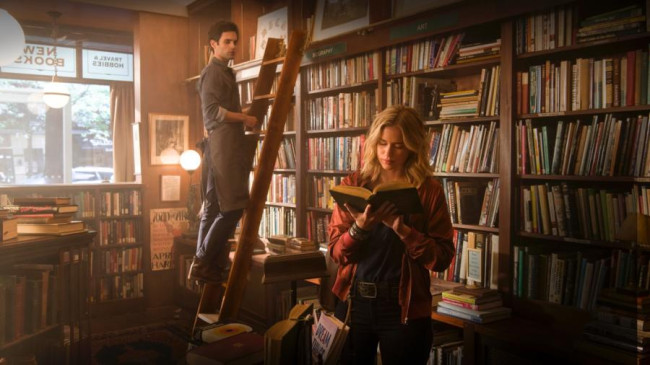The real jewels in ‘Uncut Gems’ are the over-the-top homes

Adam Sandler plays Howard Ratner, a gem dealer who is savvier about decorating than he is about love or business.
It’s safe to say that New York City’s real estate, as depicted in the newly released, big studio flick, “Uncut Gems,” is more realistic than the lead character’s teeth. Howard Ratner (played by Adam Sandler) is a middle-aged Jewish gem dealer working in Midtown’s Diamond District. He sports gaudy rings, and even showier chompers. Flashiness aside, he is also addicted to gambling—sports betting specifically—and this addiction propels his downfall.
We first see Ratner among the jewelry kiosks that 47th Street is known for and the film gets the atmosphere right with locked-off areas, framed money, an exotic fish tank, sports memorabilia and enough bling to blind Liberace. In fact, the movie features real-life Diamond-District jeweler Roman Persits, who lent his expertise to the production.
[Editor's note: When a movie or TV show is set in New York City—and if the people making it are savvy—real estate becomes part of the story itself. In Reel Estate, Brick Underground reality checks the NYC real estate depicted on screen].
The movie’s realism is immediately in question when Howard’s young side-piece-slash-employee, Julia, is seen sprawled out in his bed with a friend and she accuses him of being “extra.” While the term was first listed in Urban Dictionary in 2003, it did not become popular until 2015. However, “Uncut Gems” takes place in 2012, long before millennials would be using the term so casually.
Even though the slang is off the mark, thankfully the apartment that Howard shares with Julia is on point, real estate-wise. The sterile, post-war bachelor pad is exactly what one would expect of a shady character like Howard to use to stash his girlfriend (his wife doesn’t know about her). The fully-staffed, high-floor, rather anonymous condo, features overstuffed sectional seating, generic but tacky artwork and enough gadgets to satiate any Gen-X technophile.
According to a recent piece about the film, “Howard’s world is gaudy, gimmicky and dark. The New York pied-à-terre where he keeps his mistress seems to have been decorated entirely from a Sharper Image catalog.”
It’s not hard to imagine Howard, who wears Gucci, drives a late-model Mercedes, and hangs with celebs like The Weeknd and Kevin Garnett of the Celtics, being able to afford a glossy apartment. The unit appears to be a one bedroom and is spacious with a view of the bustling East Side. While it is not clear if he rents or owns, it’s safe to assume the pad is pretty pricey—especially since his neighbor is a former famous actor, John Amos of “Good Times” fame. Another nod to New York City-realism is the fact that Howard doesn’t seem to know any of his neighbors personally, but that doesn’t stop them from gossiping to his son, letting the cat out of the bag that he has a hot, much younger girlfriend.
Howard’s family’s home on Long Island—filmed on location—which he shares with his future-ex-wife, Dinah (played by Idina Menzel) and three kids, is spot on too. It has a similar over-the-top vibe as his apartment, but with a more feminine touch. Sectionals here are less “strip club” and more “book club,” artwork seems a bit more refined and the children’s rooms have a bed shaped like a full-size sports car and shelves of collectible toys.
One can easily assume it is worth millions, just from his walk-in closet alone, which seems to be filled with silk shirts in a glaring variety of patterns and colors.
The movie’s creators took the movie’s interior design and architecture very seriously. Sam Lisenco, the film’s production designer, tells Architectural Digest, “We had lots of conversations about what stylistically Adam Sandler’s character would strive for, assuming that the film takes place a few years ago but also assuming that he’s somebody who started making money 10 years prior to that.” The film’s designers considered “the cachet of postmodern architecture and postmodern design” and so moviegoers are seeing what appealed to Howard when he started earning serious money.
The toys and accessories are also appropriate for the era—and fitting for a sports-betting addict, like the many large screen tvs he needs to watch multiple games at once.
At a Passover seder, about to split from his wife, Howard is rattled—taunted even—by a real estate listing on Craiglist, presumably sent by his now estranged girlfriend, indicating she is moving out to a $3,500-per-month, no-fee rental. It’s unclear whether she is sending the listing to simply announce she is moving out, or whether she expects him to pay the rent on her place. Either way, he is upset—so much so he heads to the apartment, only to find all her stuff gone.
“Uncut Gems” is a cautionary tale—Howard ends up at an auction house to sell a rare Ethiopian opal— the uncut gem of the title— with disappointing results. Sadly, the jewelry in the movie is not as pricey or realistic as the real estate depicted and this, along with Howard’s poor judgment, ultimately leads to his downfall. Without revealing any spoilers, Howard would have been far better off sinking his cash into more real estate instead of get-rich-quick schemes and Blade trips to Mohegan Sun.
You Might Also Like



























